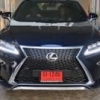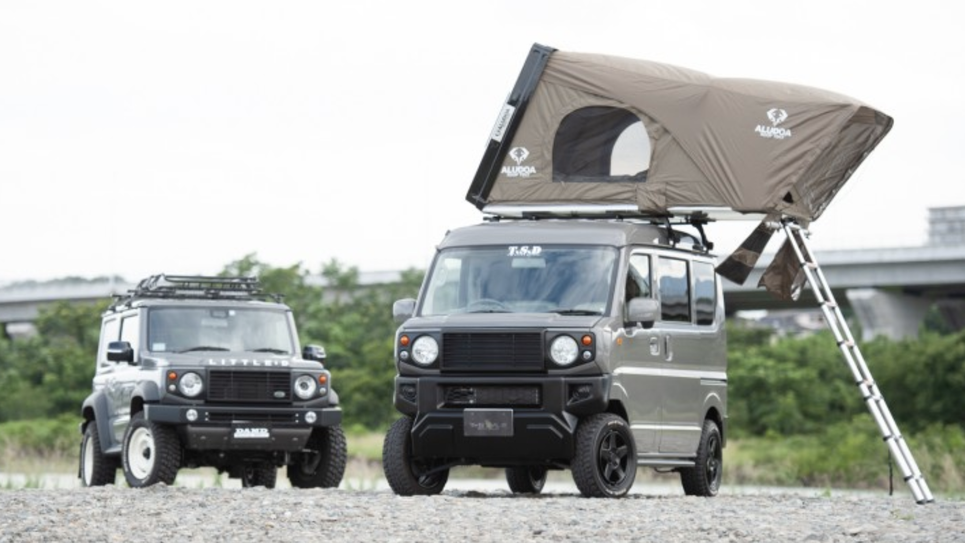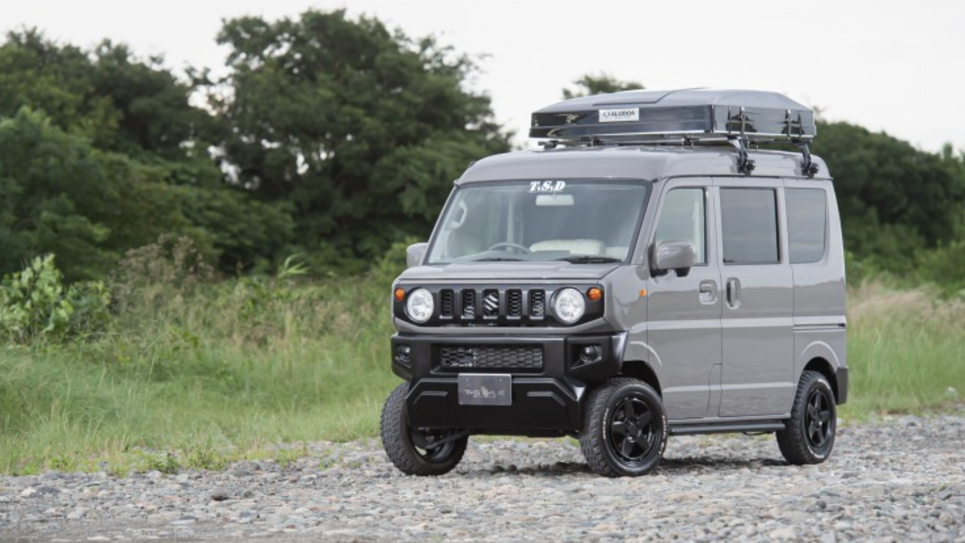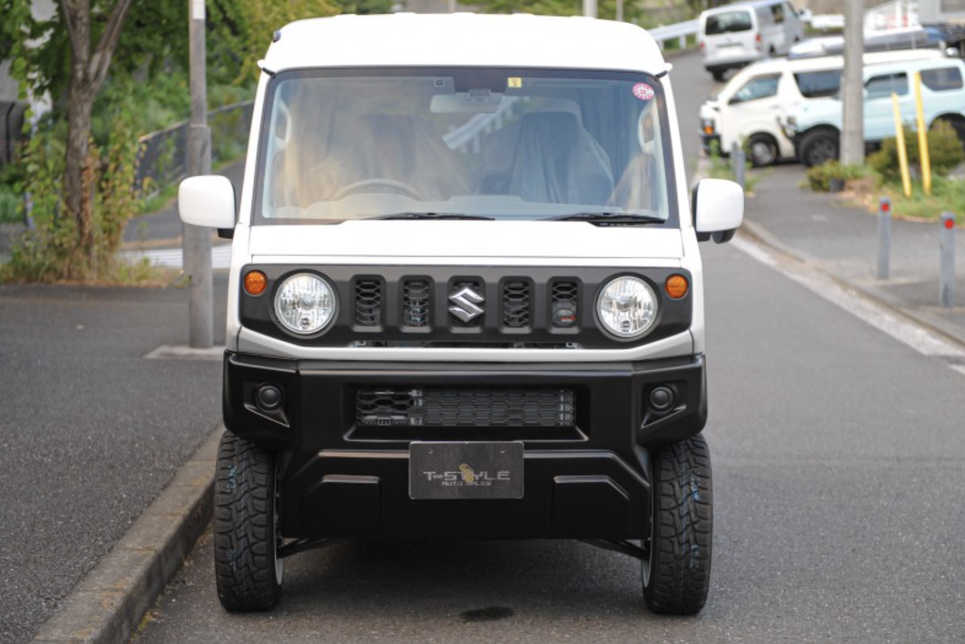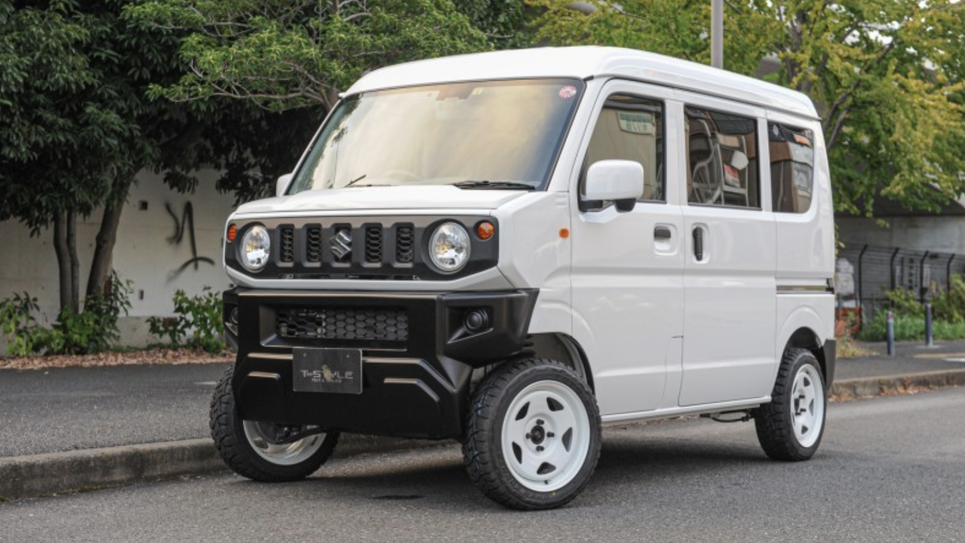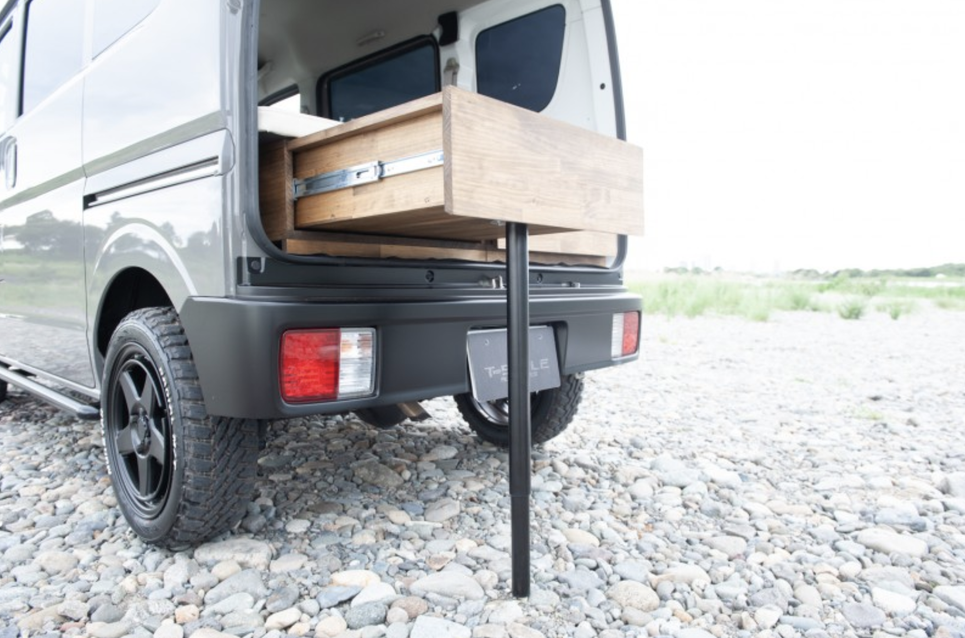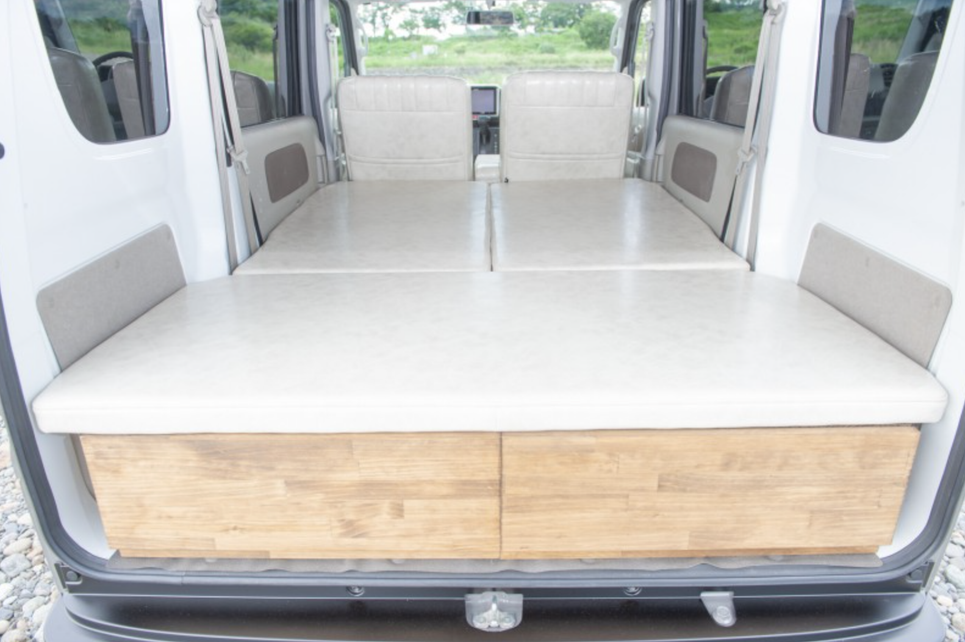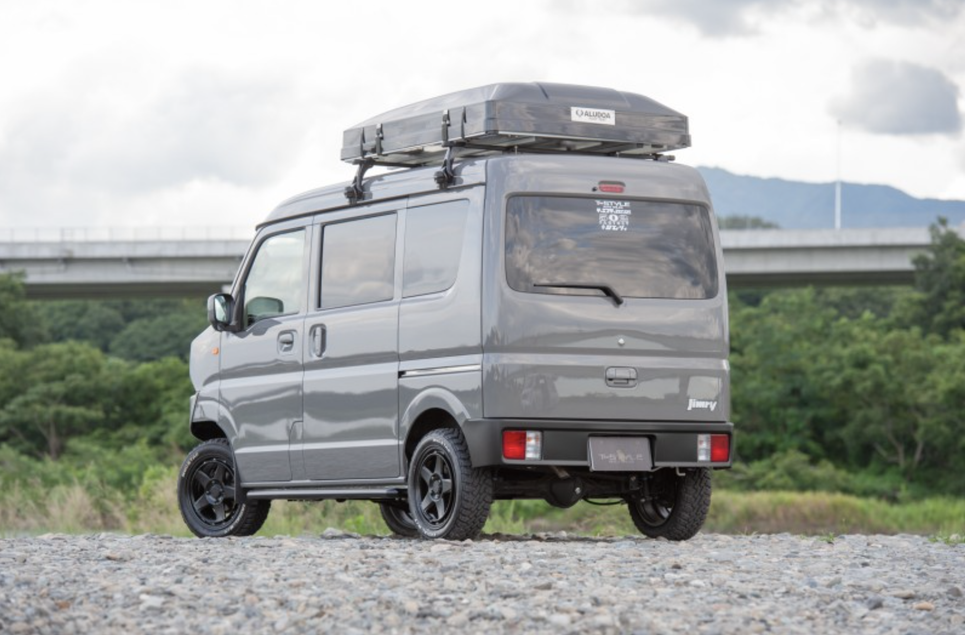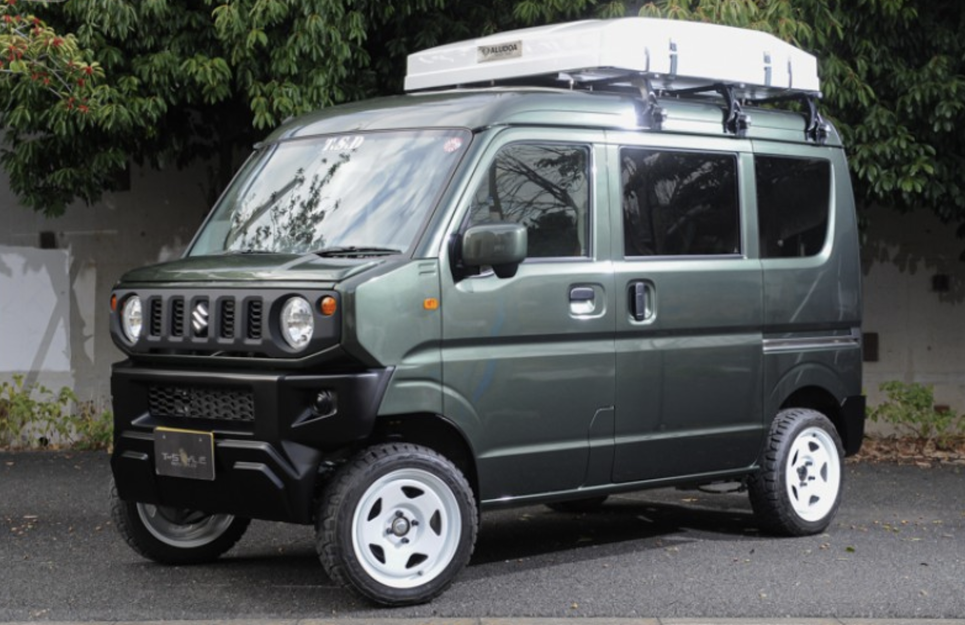Search the Community
Showing results for tags 'Japan'.
-
The spec for the PHEV look mouth watering. Dimensions 4,745 mm (L) 1,890 mm (W) 1,680 mm (H) 2,870 mm (WB) Engine 2.5L e-SkyActiv-G IL4 PHEV (323HP, 500Nm, 5.8 sec, 200Kmh) 3.0L e-SkyActiv-X IL6 mild hybrid 3.3L e-SkyActiv-D IL6 mild hybrid
- 98 replies
-
- 16
-

-
Yes, the Fairlady Z is making a come back, after 12 years... Err @Jamesc are you one of the board of directors? You just mentioned the new Z days ago! One of the Nissan model I am eagerly anticipating (although sport car is not really my cup of tea), and hopefully it stick to the original sleek design in its early days. From the video, am I the only one to see hint of the 1st gen Fairlady Z?
- 63 replies
-
- 8
-

-
.png)
-
- nissan
- fairlady z
-
(and 5 more)
Tagged with:
-
Enjoy!!! I think this MPV from Nissan. Coz Nissan and Suzuki make a deal of exchange supply programme :) Nice, but not sure CM will bring in?
-
I don't know where to post this interesting news (no humsup intention), so I started the thread. Think of it, it is quite scary to guess if the model you are seeing is real or a AI generated fantasy. To our MCF mod, is it ok? Source: https://soranews24.com/2023/05/30/ai-generated-swimsuit-lingerie-model-makes-debut-in-japans-weekly-playboy-magazine【photos】/ “Ai” is a pretty common name for models in Japan, and not just because it’s short and easy to remember. In addition to being a woman’s name, ai is also the Japanese word for “love,” so the flowery, feminine feeling it conjures up is one more way to catch the attention and affection of prospective fans. For example, here’s Ai Satsuki, the newest model being promoted by Japanese publisher Shueisha. But while Ai’s name was given to her by Shueisha, the publisher didn’t make that decision just because they hope people will fall in love with her, but because her images are generated by AI. Ai made her professional debut this Monday, appearing in the latest issue of Shueisha’s Weekly Playboy magazine. A separate entity from the American Playboy magazine), Weekly Playboy is best known for its gravure photo spreads focusing on models in swimsuits, lingerie, and other revealing outfits. In its announcement tweet, Weekly Playboy describes Ai as being “stuffed full of men’s ideals” and asserts that “Even if she doesn’t actually exist, the love for her that sprouts in your heart is real.” Despite not having a physical form, Ai is officially listed as being 157 centimeters (61,8 inches) tall, as well as being born in Tokyo and enjoying playing video games as a hobby. Along with her appearance in this week’s Weekly Playboy, Shueisha has also released 50-page digital image album for Ai titled Umaretate (“Just Born”), featuring images not included in her Weekly Playboy spread, through its Weekly Playboy Gravure Japan website. “AI gravure models? What do you think?” asked Weekly Playboy in its tweet, prompting responses including: “No scandals. No scheduling problems. No talent agency problems. No appearance fees. Sounds good.” “I want Weekly Playboy to photograph real people.” “Eventually, I think people will come around to appreciating AI gravure models.” “She’s cute!” “I hope this is a one-time thing, and doesn’t take page space away from real gravure models.” “When are we going to see an Ai Satsuki video?” “She’s cute! Following her account and going to keep an eye on what she does next.” “If you put out a physical copy of her photo album, I’m buying it.” “Things are going to get tougher for 3-D women.” “AI gravure photos are beautiful, but I prefer real ones. Actual idols have daily lives and life experiences, and I think that’s what makes fans really feel attached to them and want to help them succeed.” The last comment touches on a characteristic point of gravure idol marketing in Japan: the idea that by purchasing merchandise, attending paid-ticket meet-and-greet events, and otherwise financially supporting their favorite idol, fans are actively supporting her professional aspirations. That unique sense of satisfaction plays a big part in cultivating high-spending superfans, and whether or not a photo-realistic but AI-generated model can form the same emotional connection may be the determining factor in whether or not Shueisha, and other publishers too, press forward with AI gravure models.
- 505 replies
-
- 8
-
.png)
-

-
- artificial intelligence
- japan
-
(and 2 more)
Tagged with:
-
For discussion.... Is this good news or bad news to Singapore .... Yahoo news: Japan slides into recession as tax hike takes toll TOKYO (AP) -- Japan's economy unexpectedly shrank in the third quarter as housing and business investment declined following a tax hike, dragging the country into a recession and further clouding the outlook for the global economy. The world's third-largest economy contracted at a 1.6 percent pace in the July-September quarter, the government said Monday, contrary to predictions it would grow after a big drop the previous quarter. The surprise deepens uncertainty when China's growth is slowing and the 18-country eurozone grew only 0.2 percent in the same quarter. The gross domestic product figures showed across-the-board weakness in demand among consumers, manufacturers and builders. Many individuals and companies had spent money before the sales tax was hiked in April from 5 percent to 8 percent, and spending has languished since then. "The impact of the sales tax was much more severe than expected," said Junko Nishioka, an economist at RBS Japan Securities. Housing investment plunged 24 percent from the same quarter a year ago, while corporate capital investment sank 0.9 percent. Consumer spending, which accounts for about two-thirds of the economy, edged up just 0.4 percent. The BOJ's move, along with a government decision to shift a large share of the public pension fund investments out of government bonds and into higher yielding but riskier shares, pushed Japan's share benchmark to seven-year highs this month. But in morning trading, the Nikkei 225 stock index tumbled 2.6 percent to 17,037.65. Monday's data is preliminary, with a revision due Dec. 8. Since some of the decline was due to reductions in inventory, things may not be as bad as the GDP reading suggests, economists said. Pierre Ellis, senior economist at Decision Economics in New York, said increased business orders in the past three months for machinery, industrial equipment and other big ticket items should boost output in the coming months. Abe already was expected to announce additional economic stimulus this week. The dismal Monday morning data will probably lead him to announce a package worth about 3 trillion yen to 4 trillion yen ($26 billion to $35 billion), Nishioka said. More of stories, link: https://sg.finance.yahoo.com/news/japan-says-economy-contracted-1-000844739--finance.html Good news is Japanese cars will be cheaper if Japan into recession and COE going down... Bad news is Japan is the World's third-largest economy can go into recession, will it affect SG also ......
- 58 replies
-
- japan
- japan recession
-
(and 4 more)
Tagged with:
-
https://asia.nikkei.com/Business/Travel-Leisure/Tears-and-relief-as-Japan-fully-reopens-to-foreign-travelers?utm_campaign=GL_asia_daily&utm_medium=email&utm_source=NA_newsletter&utm_content=article_link&del_type=1&pub_date=20221011190000&seq_num=2&si=44594 Tears and relief as Japan fully reopens to foreign travellers Weak yen has tourism sector hopeful for a bonanza People arrive at Narita International Airport in Chiba prefecture on Oct. 11. (Photo by Mayumi Tsumita) RURIKA IMAHASHI, Nikkei staff writerOctober 11, 2022 17:18 JST TOKYO -- An elderly woman sat impatiently in her wheelchair in the arrival lobby of Tokyo's Haneda Airport on Tuesday morning. When her elder sister came in from a flight from Seoul, they hugged for the first time in three years in a long tearful embrace. The 76-year-old South Korean resident of Tokyo had been kept apart from her sibling by Japan's strict entry rules imposed at the onset of the pandemic. Their reunion will be just one example of a family reunited after Japan fully opened its borders on Tuesday. The country has resumed visa-free entry for individual travelers and has waived its entry cap of 50,000 per day. Travelers from most countries are exempt from quarantine and on-arrival COVID tests, although they still have to submit either a vaccine certificate or a negative COVID test result within 72 hours of departure. "We are finally here after so much waiting," said Markus Fruehwirth, a 29-year-old from Austria who will spend four weeks in Japan. He had to cancel his original plan of studying Japanese at a language school in April 2020. Fruehwirth said he plans to visit Tokyo, Osaka, Kyoto and Hiroshima, and will go to hot springs and tourist spots such as Tokyo's Ghibli Museum. With many people still wearing masks in Japan even though it is not strictly required, Fruehwirth said: "I don't have a problem with wearing a mask if it's needed. I don't have any issue with that." Foreign visitors exchange money at Kansai International Airport on Oct. 11. (Photo by Arisa Moriyama) The number of international travelers between January and August this year stood at around 820,000, down 96% from the same period in 2019, according to the Japan National Tourism Organization. Karen Carl Morrison, a tourist from the U.S., said she would spend just five hours in Japan on Tuesday before flying back to the U.S. "Originally, we were going to come to Japan for three weeks, and we booked flights months ago," Morrison said. However, she couldn't get into Japan at that time and so changed her flights to spend time in Thailand and South Korea. "This is our last day. We're flying home. But we have five hours. ... We are very happy to be here for at least a little bit of time." She planned to visit a Don Quijote discount store, a popular tourist destination. The weak yen is acting as a tailwind, as it makes travel and spending in Japan cheaper. The Japanese currency is worth 145 per dollar, a steep fall from 115 yen at the start of the year. The travel industry has high hopes. In 2019, foreign travelers to Japan spent around 4.8 trillion yen ($33 billion), a record high for the seventh consecutive year. According to Airbnb, as of Sept. 23, the top places of residence of guests who searched for accommodations in Japan on its app were South Korea, the U.S., Hong Kong, Australia and Singapore. The destinations most frequently searched for were Osaka, Tokyo, the Tokyo areas of Shinjuku and Shibuya, and Fukuoka. Some areas are already seeing a rebound in inbound business. Taiwan-based online travel startup KKday said the number of reservations for activities available in Japan between Sept. 1 and 30 increased by up to 20 times compared to the previous month. "For now, tourists tend to book activities in major cities such as Tokyo and Osaka," a representative told Nikkei Asia. But some businesses are still in wait-and-see mode. A representative for sightseeing bus operator Hato Bus told Nikkei Asia that the company is considering when to restart foreign-language tours, available in English and Chinese, which have been suspended since April 2020. People arriving at Kansai International Airport are welcomed by local government officials in ninja costumes on Oct. 11. (Photo by Arisa Moriyama) Although full reopening is giving a glimmer of hope to the travel industry, the rebound may be somewhat restricted, as travelers from China are unlikely to visit Japan anytime soon. The country shows no signs of easing its strict zero-COVID policy. In 2019, Chinese visitors accounted for 30% of tourist arrivals in Japan. "It will take time for the travel industry to recover fully," noted Wakaba Kobayashi, an economist at the Daiwa Institute of Research. Given the previous high ratio of Chinese tourists, "It will be difficult for Japan to achieve a similar reduction in the rate of decline in arrivals even if COVID border restrictions are relaxed to the level of other Group of Seven countries." Additional reporting by Kentaro Iwamoto.
-
Another facelift, for a 6 year old model... The sensor activated sliding door look interesting, and will be good if it work as intended.
- 81 replies
-
- 12
-

-
https://www.straitstimes.com/business/masatoshi-ito-who-took-7-eleven-stores-global-dies-at-98 Masatoshi Ito, who took 7-Eleven stores global, dies at 98 Mr Masatoshi Ito died on March 10 due to old age, the company said in a statement on Monday. PHOTO: BLOOMBERG 13 Mar 2023, 5:05 pm SGT TOKYO - Mr Masatoshi Ito, the billionaire who expanded a small family-owned shop into one of Japan’s largest retailers and took 7-Eleven convenience stores global, has died. He was 98. Mr Ito died on March 10 due to old age, 7-Eleven operator Seven & i Holdings said in a statement on Monday, confirming earlier reports by local media. Although his Ito-Yokado stores, which offered one-stop shopping for things from groceries to everyday clothes, lost their lustre long ago, Mr Ito’s legacy continued in the 7-Eleven franchise. The company he founded, Ito-Yokado, was the predecessor of Seven & i Holdings. There are more than 83,000 7-Elevens dotting the globe, with about a fourth of them in Japan. Mr Ito was the company’s largest shareholder, amassing a net worth of US$5 billion (S$6.7 billion), according to the Bloomberg Billionaires Index. Sometimes called the Sam Walton of Japan, Mr Ito was known for a decentralised business style that was influenced by his long friendship with famed management consultant Peter Drucker, who once described Mr Ito as “one of the world’s outstanding entrepreneurs and business builders”. Ito-Yokado traces its origin to the Yokado Clothing Store that Mr Ito’s uncle Toshio Yoshikawa opened in Asakusa, Tokyo, in 1920. Mr Ito’s half-brother Yuzuru took the lead in expanding the business but died in 1956, and Mr Ito took over. He later renamed it Ito-Yokado and took it public in 1972. The retailer continued to expand, including establishing Denny’s Japan, which brought the US-based casual restaurant chain to the country. A younger executive at Ito-Yokado, Mr Toshifumi Suzuki, discovered 7-Eleven during a visit to the United States to negotiate that deal. After forging a deal with US-based Southland Corp, then owner of the 7-Eleven chain, Mr Suzuki opened the first outlet in Japan in 1974. That business would eventually outgrow Ito-Yokado’s general merchandising segment; in 1991 the company acquired Southland’s equity. In 1992, Mr Ito resigned from his post at Ito-Yokado to take responsibility for alleged payments by company officials to three “yakuza” gangsters, to keep order at a shareholders’ meeting. Mr Suzuki succeeded Mr Ito as president, later becoming chairman and chief executive officer. He renamed the business Seven & i Holdings in 2005, and 7-Eleven Inc was made a wholly owned subsidiary. Mr Ito remained as honorary chairman of the parent company, with the “i” in the name referring to Ito-Yokado and his last name. On the urging of an activist shareholder, Seven & i is streamlining its business. In November, the retailer announced the sale of its Sogo & Seibu department stores for an enterprise value of about 250 billion yen (S$2.5 billion) to Fortress Investment Group. Last week, Seven & i said it will close roughly one out of every four of its Ito-Yokado stores in Japan. BLOOMBERG
-
To be launched officially tomorrow.
- 14 replies
-
- 8
-

-
https://edition.cnn.com/2023/02/09/asia/japan-zoo-gibbon-pregnancy-mystery-intl-hnk/index.html A gibbon who lived alone in her cage had a baby. Japanese zookeepers finally know how By Xiaofei Xu, Philip Wang and Junko Ogura, CNN Updated 2:36 AM EST, Fri February 10, 2023 CNN — Japanese zookeepers believe they have solved the mystery of how a gibbon became pregnant despite living alone in her cage. Momo, a 12-year-old white-handed gibbon, shocked her keepers at the Kujukushima Zoo and Botanical Garden in Nagasaki in February 2021 when she gave birth despite having no male companionship. Now two years later, following a DNA test on her baby, the zoo has worked out who the father is – and even has a theory about how the gibbons mated. The test showed the father to be Itō, a 34-year-old agile gibbon, who was in an adjacent enclosure to Momo around the time she became pregnant. The zoo told CNN on Friday it believed that Momo and Itō had managed to mate through a small hole in a steel plate between their enclosures. The hole measured about 9 millimeters (0.3 inch) in diameter. Momo the gibbon and her baby at the Kujukushima Zoo. The baby ape – who is yet to be named – now weighs around 2 kilograms (4.4 pounds) and is “growing healthily” under Momo’s loving attention, the zoo said. “It is a precious life born into the world, we will continue to take good care of him and hope that he will live a healthy long life,” said Hideki Hisano, deputy director of the zoo. Gibbons are among the smallest apes, but they have loud singing voices that have developed into an elaborate language, and can swing from branch to branch at speeds of up to 35 miles per hour. There are dozens of gibbon species that are native to parts of Asia, ranging from northeastern India to China and all the way to the Borneo archipelago. The population of agile gibbons in the wild has been decreasing and they have been listed as an endangered species in the International Union for Conservation of Nature, because their habitat is threatened by human activities such as deforestation, mining and road construction.
-
https://asia.nikkei.com/Business/Automobiles/China-s-BYD-starts-EV-sales-in-Japan-as-it-chases-Tesla?utm_campaign=GL_asia_daily&utm_medium=email&utm_source=NA_newsletter&utm_content=article_link&del_type=1&pub_date=20230131190000&seq_num=9&si=44594 China's BYD starts EV sales in Japan as it chases Tesla Elon Musk's company has global lead but affordable option has entered the race BYD, which has made a big name for itself in China, intends to catch up with Tesla in global electric vehicle sales. (Source photos courtesy of BYD and Getty Images) SAYUMI TAKE, Nikkei staff writerJanuary 31, 2023 18:15 JST YOKOHAMA, Japan -- Chinese automaker BYD began selling electric vehicles in Japan on Tuesday as it pursues its global ambitions to overtake more established nameplates. BYD's debut in the world's fourth largest auto market comes with it having secured its place as China's top EV seller and nipping at the heels of American EV giant Tesla in global EV sales. BYD also sells electric vehicles in Australia and Thailand, and has production plants in South America. "We're very excited to be bringing our cars to Japanese customers," said Atsuki Tofukuji, president of BYD Auto Japan, a marketing subsidiary. Tofukuji talked to reporters at BYD's first Japanese sales location, due to open on Thursday in Yokohama, the big port city south of Tokyo. While the Chinese automaker is gaining fame as an EV battery seller, its car sales remain largely dependent on domestic demand. This puts it considerably behind Elon Musk's top-running Tesla, which has penetrated many more global markets. BYD has been eager to close the gap and recently began exporting to India, home to a fledgling EV market, and to Thailand, where it plans its first ASEAN production hub. The Atto 3, which went on sale on Jan. 31 in Japan, has already attracted a "fair amount" of test-drive reservations from prospective buyers. (Photo by Sayumi Take) BYD is entering Japan with a key strength against Tesla, affordability, backed by its roots as a battery maker. The company's flagship Atto 3 midsize SUV, which today went on sale in Japan, goes for 4.4 million yen ($33,800), cheaper than Tesla and Nissan EVs. Government EV subsidies, if they continue, will lower the price. Deliveries are to begin around March. The Yokohama store is also "a good way to present new brands to Japanese customers" as they can actually familiarize themselves with EVs and consult professional dealers about purchases on the spot, Tofukuji said. It is the first of over 20 showrooms that BYD plans to establish across Japan this year. The company aspires to have over 100 dealerships in the country by the end of 2025. This contrasts with Tesla, which largely relies on internet sales. BYD's showroom in Yokohama only has the Atto 3 on display but later this year will exhibit two additional models. Visitors can also take the SUV out for test drives, and the store is already receiving a "fair amount" of reservations. Each BYD dealer in Japan will be equipped with 50-kilowatt quick chargers that can juice up the Atto 3 in about 60 minutes. Japan's EV market has been expanding, though notably slower than other countries. Domestic EV sales in 2022 came to about 59,000 units, a record and almost triple the previous year's total, according to industry groups. They accounted for 1.7% of Japan's passenger car market, surpassing 1% for the first time. But most of the growth is due to vehicles that fall into the kei car category. These microcars are considered to be easy to drive around crowded cities and require relatively low maintenance. And since they need little power, their makers have been able to more easily transition to electric drivetrains. The rest of the industry faces a relatively large obstacle: Many chargers in the country operate on such low power that it takes hours to sufficiently juice up a regular EV. BYD's strategy is to "introduce products that fit each country's charging environment," Tofukuji said, "unlike Tesla, which distributes chargers exclusive to its models." Despite Japan's slowly developing EV market, BYD faces a raft of competitors. Foreign luxury brands like Mercedes-Benz, Tesla and Audi are eager to take big shares of the young market. And although Japan's storied auto industry is filled with EV laggards, those dawdlers are moving to catch up. Toyota recently named a new president and CEO, tasking the relatively young executive with adapting to today's industry trends. "The Japanese EV market overall is getting bigger, and this is a good time to be entering [the competition]," Tofukuji said. "We hope to provide a rich EV life along with the development of Japan's EV environment."
-
https://asia.nikkei.com/Business/Food-Beverage/Underwater-aging-adds-deep-taste-to-Japanese-sake?utm_campaign=GL_asia_daily&utm_medium=email&utm_source=NA_newsletter&utm_content=article_link&del_type=1&pub_date=20230126120000&seq_num=24&si=44594 Underwater aging adds deep taste to Japanese sake Drinkers gulp up sake matured in the ocean in search of luxury, uniqueness Shiraki Brewery's underwater-aged Daruma Masamune is kept submerged long enough for shellfish to attach themselves to the bottles. (Photo courtesy of Shiraki Brewery) HAYATO SAWA, Nikkei staff writerJanuary 22, 2023 14:30 JST TOKYO -- Sake aged underwater is drawing the attention of drinkers, with fans saying the waves and stable temperatures of the ocean environment give the brews a unique flavor compared with those aged aboveground. Despite a steady decline in Japan's overall sake consumption, those made with unique aging methods sell well. Sake matured beneath the waves, for one, is a popular gift that offers a sense of luxury and rarity. Last month, Forbul, a Tokyo-based sake maker, began selling a product aged for about two years called Takanome: Underwater Aging. The brewer submerges its bottled Takanome premium sake 15 meters underwater off the coast of Minami Izu, in Shizuoka prefecture southwest of Tokyo for six months. It then ages it in a warehouse at -5 C for another 18 months. It is said that sake matures more quickly and tastes milder than conventional brews. Among the various theories for why this is so, the most plausible is that certain vibration frequencies occur due to the wave action, affecting the chemical composition of the sake. There is also less variation in temperature when sake is aged underwater versus aboveground. The submarine environment also provides "natural storage," and an ideal place for the maturation process, as seawater temperatures are lower in winter and the currents stronger than in other seasons. Forbul sells only 300 bottles of underwater-aged sake, which have five different flavor profiles. The company says even brews that are aged on the same seabed or for the same amount of time taste different, depending on the waves at the time. A 720 ml bottle ranges in price from 33,000 to 60,000 yen ($257 to $468), including tax and shipping. All five sakes are touted as complementing various foods. Unkai ("Sea of Clouds"), for example, has pineapple hints, with a refreshing acidity and sweetness. It goes well with salty white fish dishes, according to the company. Forbul sinks its Takanome premium sake 15 meters beneath the waves off the coast of Minami Izu, in Shizuoka prefecture, maturing the brew underwater for six months. (Photo courtesy of Forbul) The two products introduced in December have already sold out and the remaining three will go on sale later this month. A 180 ml bottle of Takanome, the same sake minus the undersea aging, will be sold as a package with the aged brew, allowing customers to compare. Takanome, which Forbul introduced in 2019, is known as a rare brew and typically sells out within five minutes after it goes up for sale every Wednesday on the company's website. Seiya Hirano, Forbul's representative director, said the company is a pioneer when it comes to aging, adding that it plans to do research on aging in barrels and other methods. Japan's sake market has been shrinking due the country's declining population and shifting tastes. About 400,000 kiloliters of sake were shipped in 2021 in Japan, less than a fourth of the peak figure in 1973. As it is becoming harder to sell sake in large volumes, breweries across Japan are competing to add value to their products with unique aging methods, such as Forbul's underwater maturation. Shiraki Brewery in the central Japanese city of Gifu, also goes for submarine maturation and has been making such brews since 2013. The brewery ages its bottled Masamune sake 15 to 20 meters underwater in Minami Izu from November until June. Daruma Masamune, the underwater-aged version of the brew, which features bottles naturally encrusted with seashells, goes on sale around July every year. A 720 ml bottle is priced at 8,250 yen. Daruma Masamune is popular with men in their 30s and 40s, with many customers buying it for its unique flavor and the look of the bottle. "Underwater-aged Daruma Masamune sells out every year and many customers continue to buy it," CEO Shigeri Shiraki said, adding that there are also inquiries from Taiwan and elsewhere. "Breweries are making efforts to age sake utilizing the characteristics of each region, such as underwater and in snow rooms," said Yasuyuki Kishi, a professor at Niigata University who specializes in the craft. Such unique twists on the ancient art may be the key to stirring an industry caught in the doldrums.
-
As I have mentioned in a few threads here, China is the leader in EV development and many big names in the automotive industry are trying hard to form JV with some of these well establish EV manufacturers. And I vividly remember 1 MCFer even asked for 'China Talk' folder to be removed from the forum, wait till you see the motoring trend in the next 3 - 5 years... BTW, noticed that it is BYD Toyota EV Technology instead of Toyota BYD EV Technology? BYD, Toyota Launch BYD TOYOTA EV TECHNOLOGY Joint Venture to Conduct Battery Electric Vehicle R&D Toyota City, Japan, April 2, 2020―BYD Company Ltd. (BYD) and Toyota Motor Corporation (Toyota) announced today that preparations have proceeded since they signed an agreement for the establishment of a joint venture company to conduct research and development of battery electric vehicles (BEVs) on November 7, 2019, and registration of the new company has been completed. Operations are scheduled to commence in May 2020. The name of the new company is BYD TOYOTA EV TECHNOLOGY CO., LTD. (BTET). Hirohisa Kishi from Toyota will serve as chairman, and Zhao Binggen from BYD will be the chief executive officer (CEO). New Chairman Hirohisa Kishi said with regard to the establishment of the company, "With the engineers from BYD and Toyota working together under the same roof, we aim to develop BEVs that are superior in performance and meet the needs of customers in China by merging the two companies' strengths and also through friendly rivalry." Newly appointed CEO Zhao Binggen commented, "This joint venture company will focus on the research and development of battery electric vehicles with technology and know-how from both China and Japan. The company is committed to promoting and populating high-quality technologies that make battery electric vehicles more environmentally friendly, safe, comfortable, and intelligent. Our vision is to create a future customer-first mobility style, and a harmonious society for humans and nature." BYD and Toyota will work together to meet the diverse needs of customers by researching and developing BEVs that appeal to customers and promoting their widespread adoption and also hope to contribute to improving the environment in China. Overview of the Joint Venture Company Name: BYD TOYOTA EV TECHNOLOGY CO., LTD. (BTET) Location: Head officePingshan District, Shenzhen City, Guangdong Province Chairman: Hirohisa Kishi (Senior Executive Vice President, Toyota Motor Engineering & Manufacturing (China) Co., Ltd.) CEO: Zhao Binggen (BYD Company Ltd.) Directors: 6 (3 from Toyota and 3 from BYD) Auditors: 2 (1 from Toyota and 1 from BYD) Business Activities: Design, development, etc. of battery electric vehicles and their platforms and related parts Equity participation: Toyota Motor Corporation (50%), BYD (50%) Employees: Approx. 300
- 18 replies
-
- 10
-

-
.png)
-
https://www.channelnewsasia.com/asia/japan-test-tourism-package-tours-reopening-may-2689346 https://www.straitstimes.com/asia/east-asia/japan-to-allow-small-groups-of-tourists-to-visit-this-month Japan Kakis fall in! But alamak need to travel by travel agency/tour group, pre-determined itineraries approved by their government, travel guide at all times and need to have 3 COVID-19 shots and COVID insurance. I'm surprised USA is on the same shortlist as Singapore. The Tourism Agency said on Tuesday that it would start allowing small group tours to enter from later this month as "test cases" to gain information for a broader resumption of tourism at an unspecified future date. Tourists who have been triple-vaccinated and come from the United States, Australia, Thailand and Singapore will be allowed to take part in the tours, which will be strictly planned in conjunction with travel agencies and accompanied at all times by tour conductors, it added in a statement. "This venture will allow us to verify compliance and emergency responses for infection prevention and formulate guidelines for travel agencies and accommodation operators to keep in mind," it said. The four countries are recognised as having lower Covid-19 risk of mutant strains, and are key priority markets for Japan.
-
https://asia.nikkei.com/Business/Food-Beverage/Japanese-whisky-draws-collectors-thirsty-for-fun-profit?utm_campaign=GL_JP_update&utm_medium=email&utm_source=NA_newsletter&utm_content=article_link&del_type=4&pub_date=20220809090000&seq_num=20&si=44594 Japanese whisky draws collectors thirsty for fun, profit Suntory brand rises 50% in past two years as COVID attracts speculators Previously, whisky collectors were generally wealthy people who sought rare and expensive vintages. The COVID pandemic has brought in speculators looking to make a quick profit. © Reuters HIROKI MASUDA, Nikkei staff writerAugust 7, 2022 14:30 JST TOKYO -- Trading prices for popular Japanese whisky brands have risen 50% over the past two years amid a general rise in prices for the spirit. Whisky consumption is rising, thanks to its versatility for the home market: There are many brands and it can be enjoyed in many ways. Enthusiasts gravitate to specific whiskies based on everything from how they are made and their age to bottle designs. Some collectors are more interested in owning bottles than in drinking the contents. One man in his 50s in Saitama Prefecture, north of Tokyo, epitomizes the trend. He said his passion for collecting whisky bottles has grown so intense that he searches online daily for new ones to buy. He sometimes spends tens of thousands yen (several hundred of dollars) buying whisky online or at brick- and-mortar shops. Viewing his collection of mini bottles at home is a joy, he said. "I became a serious collector just about a year ago," the man said. "I first read about a limited sale of a Japanese whisky brand and my interest grew from that point." Surprisingly, he is not a drinker. He simply enjoys collecting different brands, delighting in subtle differences in bottle designs. "Whenever I find a mini bottle that I don't have, I want it," he said. The growing popularity of whisky is evident in the rising prices offered by resellers to those willing to part with bottles of alcoholic beverages. Joylab, one reseller inTokyo, offered 10,000 yen ($76.50) for a 700 milliliter bottle of Yamazaki, a single malt whisky brand from Suntory, in June. That was 2,500 yen, or 33%, higher than for same month a year ago and 3,500 yen, 54% more than same month two years earlier. A 700 ml bottle of Hakushu, another Suntory's single malt, fetched 8,000 yen, up 3,000 yen, or 60%, from two years earlier. These brands are nonvintage products. Still, Japanese whiskies, which must undergo saccharification -- the breaking down of carbohydrates into ethanol -- fermentation and distillation at a Japanese distillery, are popular with connoisseurs and command a premium. Whiskies were once seen as a plaything for wealthy collectors eager for rare and pricey vintage products. The current fad for Japanese whiskies began in China around 2015. Some change hands at substantial markups and can be hard to obtain. Then speculators piled in -- people looking for a place to put their money as the COVID-19 pandemic raged. Reports of a Japanese whisky fetching tens of millions of yen at an overseas auction also put Japanese whiskies in the spotlight. More recently, consumers of more modest means have begun collecting Japanese whiskies, expanding the breadth of the demand. Whisky collectors choose products based on everything from production methods to bottle design. Consumer demand is also driven by the growing trend toward drinking at home. On social media, many people enjoy sharing their knowledge of whisky, according to Joylab President and CEO Keisuke Ota. "Hurdles have come down and it's now easier" for people to access information and enjoy whiskies, which encourages people to drink whisky, Ota said. The growing crowd of whisky enthusiasts on social media has, in turn, led to demand from people hopping on the collecting bandwagon, whether or not they actually consume them. "As information is becoming more easily accessible through diverse media, people are having fun boasting of their knowledge and finding their own ways of enjoying" the product, said Ryo Hirose, a researcher at Tokyo think tank NLI Research Institute. "Owning Japanese whiskies and boasting about one's knowledge of them is like a high social status thing for some people," said Tomohiro Toma, who manages the Kasukabe branch of Daikokuya, chain of secondhand shops. This is not so different from earlier booms in trading cards and sneakers. It appears that people's hunger for knowledge, which might have been sated by things like travel, is being directed toward objects due to the pandemic. Because age is a key determinant of how much a whisky is worth, the supply of a sought-after brand does not increase overnight. This contributes to the hot market. The flavors of a single batch can also vary, even if the whisky matures in casks made of the same material and under the same storage environment. As different casks can result in different flavors, distillers cannot easily replicate them. Suntory is a large producer and has the resources to invest in the best production equipment, but it still has not "been able to respond to all types of demand," a company spokesperson said. As supplies remains tight, some speculators buy sought-after bottles in order to resell them at a higher price on flea market apps. The temptation to sell counterfeits online is strong. The Japanese whisky fad, while generally good for business, has raised concerns among many in the industry. Retailer Bic Camera is working to introduce measures, such as selling popular whisky brands to customers by lottery as a way to ensure that "whisky lovers can purchase products in a fair environment, given the rise in purchases for reselling purposes," according to a company spokesperson. "Purchase prices have already reached high levels and I don't see much possibility for them to go up much further," said Joylab's Ota. He thinks the market may cool as consumers are pushed out of the market by rising prices. The end of the Japanese whisky boom may be on the horizon -- or not.
-
The new model seems to be targeting at Hyundai Santa Fe and Kia Sorento, basing on its size. And should be a proper 7 seater SUV since Japanese is typically better with space utilisation.
-
https://asia.nikkei.com/Politics/Malaysia-in-transition/Malaysian-official-tells-Muslims-to-shun-Japanese-festival?utm_campaign=GL_asia_daily&utm_medium=email&utm_source=NA_newsletter&utm_content=article_link&del_type=1&pub_date=20220627190000&seq_num=14&si=44594 Malaysian official tells Muslims to shun Japanese festival Minister cites 'religious elements' in decades-old gathering -- but not without pushback A traditional Japanese dance known as Bon Odori is performed at a festival in southern Malaysia in July 2019. (Photo by Takashi Nakano) TAKASHI NAKANO, Nikkei staff writerJune 27, 2022 06:38 JST SINGAPORE -- A traditional Japanese summer festival in Malaysia that dates back to 1977 has found itself embroiled in political controversy as a cabinet minister advises Muslims to stay away in a move possibly meant to draw votes in an upcoming election. Held on the outskirts of Kuala Lumpur, the annual Bon Odori event is organized by the Japan Club of Kuala Lumpur, the club's Japanese School of Kuala Lumpur, and the Japanese Embassy. Its 35,000 or so participants include not only Japanese expatriates, but also Malaysians interested in Japanese culture. After cancellations for 2020 and 2021 over the COVID-19 pandemic, the festival is slated to return this year on July 16. But a cabinet member has put a damper on the excitement. A study by the Malaysian Islamic Development Department "found that the festival does have religious elements, so we advise Muslims not to participate in it," said Idris Ahmad, the minister for religious affairs in the Prime Minister's Department, earlier this month. Idris is a vice president of the conservative Malaysian Islamic Party (PAS). Others, including the women's wing of the party, have voiced support for the boycott. But the calls have met with resistance, including from the monarch of the state where the event is slated to be held. "The Bon Odori festival, which has been celebrated in Malaysia for decades, is just a cultural cerebration," said the sultan of Selangor, Sharafuddin Idris Shah Alhaj, in a statement on June 9. The ruler, who noted that he attended in 2016, has summoned PAS leadership to try to resolve the situation. The sultan "did not want certain parties, especially politicians, to use issues that touched on such religious sensitivities for personal gain and to gain popularity alone," the statement said. The Japan Club of Kuala Lumpur weighed in by touting the festival's significance. "As this year marks the 65th anniversary of the establishment of the diplomatic relations between Japan and Malaysia, as well as the 40th anniversary of Malaysia's Look East Policy, the organizing committee of the Bon Odori with all the partners hope that the occasion will serve as yet another opportunity to bond the two peoples of Japan and Malaysia," it said. Currently, the festival is expected to be held as scheduled. The PAS likely brought up the Bon Odori issue with an eye on the general election to be held as early as this year. The PAS is part of the ruling coalition now but is expected to part ways with the United Malays National Organization -- the leading party in the government. As Malays -- who, together with other native peoples, make up around 70% of the population -- form the base for both parties, the PAS hopes to expand support by highlighting the identity of Malay Muslims. But politicizing a cultural event risks fueling discord among residents from different ethnic groups or cultures. Malaysia experienced sectarian violence in 1969 when Malays clashed with ethnic Chinese residents. "It is unfortunate that PAS tried to bolster its religious credentials by playing up the issue, while propagating a divisive attitude," said Lee Hwok Aun, a senior fellow at the Singapore-based ISEAS-Yusof Ishak Institute. While noting that many Malaysians likely do not have strong feelings about Bon Odori, Lee still sees cause for concern "because PAS is influential and there is little indication that the party will shift toward a more inclusive disposition in the near future."
-
Lexus show off electric LFA successor at Goodwood! https://insideevs.com/news/594373/lexus-lfa-successor-goodwood/amp/
-
With this, is Sony signalling to the world its intention to venture into EV manufacturing?
-
https://asia.nikkei.com/Politics/International-relations/Indo-Pacific/Kishida-Japan-to-fundamentally-strengthen-defense-in-5-years?utm_campaign=GL_JP_update&utm_medium=email&utm_source=NA_newsletter&utm_content=article_link&del_type=4&pub_date=20220611090000&seq_num=5&si=44594 Kishida: Japan to 'fundamentally' strengthen defense in 5 years At Shangri-La Dialogue, PM vows $2bn in Indo-Pacific aid for 'new era' of realism Japanese Prime Minister Fumio Kishida delivers the keynote speech to the Shangri-La Dialogue in Singapore on June 10. © Reuters TSUBASA SURUGA, Nikkei staff writerJune 10, 2022 22:32 JST SINGAPORE -- Japan will "fundamentally reinforce Japan's defense capabilities within the next five years," Prime Minister Fumio Kishida vowed in Singapore on Friday, delivering a keynote address to open the Shangri-La Dialogue security summit. Kishida pledged to "secure a substantial increase" in the country's defense budget to back this up, stressing that Japan has adopted a new type of "realism diplomacy for a new era." His more than 30-minute speech to the forum, where defense ministers and delegates from 42 countries are gathering, came in the shadow of Russia's invasion of Ukraine and as China's rise shifts the balance of power in the Indo-Pacific region. Kishida also promised to provide maritime aid to Indo-Pacific countries -- at least $2 billion over the next three years for maritime security equipment, including patrol vessels, and to support maritime transportation infrastructure. "We will strengthen our support to each country, utilizing cooperation of the Quad and frameworks of international organizations," he said, referring to Japan's loose security partnership with the U.S., Australia and India. In May, the Japanese leader had told visiting U.S. President Joe Biden in Tokyo that his government would reinforce Japan's defense capabilities and raise its budget. On Friday, Kishida pointed to the Ukraine war as part of the rationale for doing so. "I myself have a strong sense that Ukraine today may be the East Asia [of] tomorrow," he said. "I will seek to build a stable international order through dialogue, not confrontation," he promised. "At the same time, however, we must be prepared for the emergence of an entity that tramples on the peace and security of other countries by force or threat without honoring the rules." The groundwork for a defense buildup was laid on Tuesday, when the Japanese cabinet approved the first annual economic policy road map since Kishida took office last year. The blueprint for next fiscal year's budget said Japan aims to drastically increase its defense outlays over the next five years, without specifying exactly by how much. The road map did refer to the defense spending commitment made by NATO members -- 2% of gross domestic product. Japan currently spends close to 1% of its GDP. While Kishida highlighted the Ukraine war, and did not single out China by name, he alluded to longstanding concerns about Beijing's assertive behavior especially in the maritime domain. On the South China Sea -- where China has overlapping claims with several Southeast Asian countries -- Kishida said that international law and in particular the United Nations Convention on the Law of the Sea, along with arbitration decisions based on that convention, are not being "complied with." He went on to warn that "unilateral attempts to change the status quo by force in violation of international law are continuing." He also touched on tensions in the Taiwan Strait, saying that "peace and stability" in the waterway are "of extreme importance." Russia's invasion has raised fears of China one day trying to take Taiwan -- which it regards as a renegade province -- by force. Just ahead of Kishida's speech, the U.S. and Chinese defense chiefs had a face-to-face meeting in which they exchanged views on Taiwan. The Japanese destroyer Inazuma is pictured in the Indian Ocean in 2018: Tokyo intends to ramp up defense spending at a time of high regional tension. © Reuters In 2021, Japan's military spending was estimated at a record $54.1 billion, ranking ninth globally. The total came to less than a fifth of China's $293 billion, which ranked second behind only the U.S., at $801 billion, according to the Stockholm International Peace Research Institute. India came in third at $76.6 billion. Still, the rate of increase in Japanese defense spending was notably high, at 7.3% on the year. The government allocated an additional $7 billion to defense in a supplementary budget, resulting in the highest annual growth rate since 1972. Despite Kishida's insistence on adding muscle to Japan's forces, he also offered reassurance in his speech. "I stress that Japan's posture as a peace loving nation will remain unchanged," he said. "Our efforts will proceed within the scope of our constitution and in compliance with international law, in a manner that does not alter the basic roles and missions shared between Japan and U.S. under our alliance." The U.S. and Japan have traditionally divided their roles in their alliance as that of a "spear" and a "shield." Japan has focused on being the shield, or defending Japanese territory, while leaving all attack roles to the U.S. Some in Washington have been hoping that Japan might expand its role to that of a spear, however short that spear may be, to strengthen deterrence. Kishida's point that the "roles" will be unchanged is likely an attempt to ease fears that Japan may be speeding ahead too fast, ahead of the upper house elections next month. But his remarks could be met with disappointment stateside.
-
Another war going on in the cyber world and this is no joking matters, especially if it hit those critical service providers in health care, energy, transport, telecommunications sector for example. Auto giant's supplier hit by ransomware; factories due to restart Wednesday NAGOYA -- Toyota Motor on Tuesday halted operations at all of its plants in Japan after a major supplier was hit by a cyberattack, disrupting the automaker's parts supply management system. The company is suspending 28 lines at 14 plants. Subsidiaries Hino Motors and Daihatsu Motor will also halt operations at some plants in Japan on Tuesday. The announcement that operations would be halted came on Monday, confirming an earlier Nikkei report. Toyota later announced that operations across Japan will resume on Wednesday. "We apologize to our relevant suppliers and customers for any inconvenience this may cause," Toyota said. The cyberattack hit Kojima Industries, which supplies plastic parts to Toyota. Kojima announced on Tuesday morning that it has received a message demanding ransom and that it has confirmed the existence of a virus. On Monday, an official close to Kojima Industries told Nikkei: "It is true that we have been hit by some kind of cyberattack. We are still confirming the damage and we are hurrying to respond, with the top priority of resuming Toyota's production system as soon as possible." The company said on Monday it was still investigating the origin of the cyberattack, the specific malware involved and the damage caused. "Toyota representatives and cybersecurity experts are at Kojima Industries to determine the cause and how to restore" the system, a source familiar with the situation said. Many of the roughly 400 tier 1 suppliers that Toyota deals with directly are connected to the automaker's kanban just-in-time production control system, which allowed the problems at Kojima Industries to spill over to Toyota. The automaker halted production to prevent longer-term damage, and prioritized inspection and recovery of the system. Hino will suspend all operations at its Koga facility, which manufactures large and midsize trucks for export and domestic sale, and its Hamura plant, which makes small trucks and handles production for Toyota. The automaker has yet to determine whether work will resume Wednesday. The Toyota shutdown includes a Daihatsu plant in Kyoto Prefecture. The halt is expected to reduce output by a few hundred vehicles. "We are aware of media reports" on the incident, Prime Minister Fumio Kishida told reporters Monday night. "The government is working to confirm the situation." Law enforcement is also looking into the matter.
- 26 replies
-
- 13
-

-

-
The spy photos aren't the best quality – they look like they were taken from quite a distance – and camouflage hides the finer details. However, we can see that it should wear new clothes even if the underpinnings carry over unchanged, which is the current rumor. It'll borrow design cues from the redesigned Nissan Juke while taking inspiration from Nissan's IMQ concept. You can see the Juke's influence at the rear with the prominent rear quarter panels and sloping hatch glass. The interior is expected to receive a major overhaul with a new dashboard design and a revamped infotainment system. Nissan will begin focusing on electric vehicles instead, using two new hybrid systems. One is suspected to be the company's ePower system that pairs a gasoline engine with batteries and an electric motor. The other could be a plug-in hybrid system relying on Mitsubishi's experience in the arena. Other gasoline engines will likely feature mild-hybrid setups to increase efficiency.
- 35 replies
-
- 13
-

-
Another typhoon that badly hit Japan. http://www.channelnewsasia.com/news/asia/typhoon-hagibis-tokyo-central-japan-left-devastated-11995730
-
<The Suzuki Jimny Fuses With The Suzuki Every To Make The Cutest Overland Kei Car The custom Jimry is a Jimny with a sleeper compartment. Kind of. Photo: T-Style A tuner in Yokohama, Japan combined the looks and off-road capability of the Suzuki Jimny with the passenger capacity and space efficiency of the Suzuki Every. The combination producing what T-Style Design calls the Suzuki Jimry, an overland kei car that may not have the off-road chops of the Jimny, but certainly has the attitude. This is probably as close as we’ll get to a Jimny with sliding van doors and I love it. The Jimry is built using the Suzuki Every as a base according to Autocosmos, but it has some modifications to its suspension that make it more trail worthy. Photo: T-Style The stock Suzuki Every sits almost 6 inches off the ground, and the Jimry mods raise it by 1.5 inches for a total of 7.5 inches of ground clearance. The stock 13-inch tires are replaced by 14- or 15-inch tires, depending on the build. Some Jimry builds are 4WD, but not all. And others get even more ground clearance, up to four inches over stock. The Jimry keeps the Every’s 660cc three-cylinder engine to comply with Kei car regulations. That engine makes about 63 horespower and 70 lb-ft of torque. Many of the conversions from TSD come with a five-speed manual transmission, but some get an automatic gearbox. Other gear includes a top box and rooftop tent, along with custom mudguards and bumpers that add to the Jimny look. Of course, it wouldn’t be complete without the Jimny grille. The grille sits below what looks like the tiniest “hood” ever, but since the Suzuki Every is a cabover design, the hood is not covering an engine. And I’m unsure if it’s the stocky dimensions or stand-offish front end but I’m getting Hummer H2 vibes. Even then, I still can’t help but love all the Jimry builds. Photo: T-Style Photo: T-Style The mods keep going into the interior, which has slide-out storage compartments beneath a modular bed. The bed sits atop the rear seats when these are folded and it takes up the entire rear portion of the cabin. That’s only in one of the Jimry builds advertised by TSD, and it looks like the mods are made to suit the owner. Prices for the Jimry range from $21,725 to $22,337 or so. That’s for whole Jimry builds. Autocosmos reports that the modifications alone start at around $2,178. Photo: T-Style Photo: T-Style Photo: T-Style Photo: T-Style Photo: T-Style>








